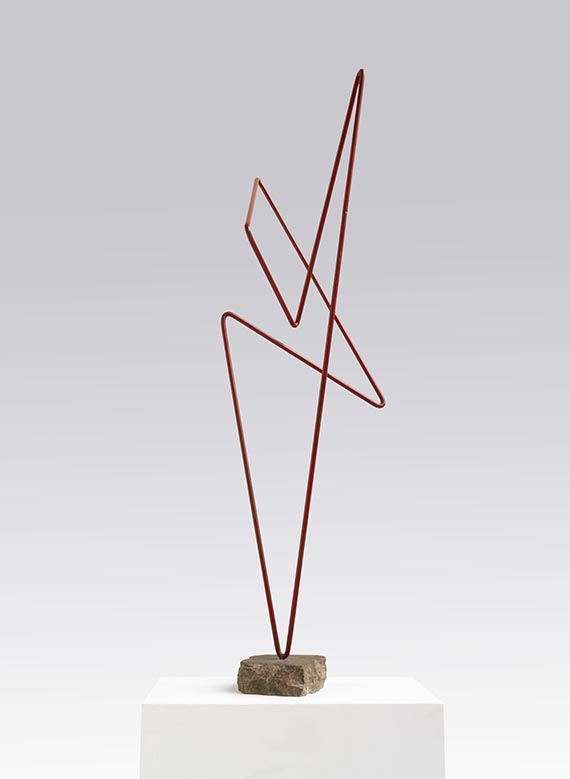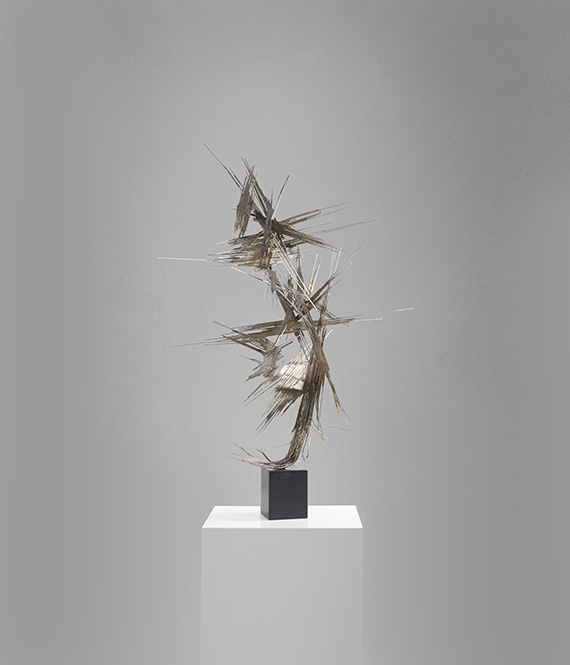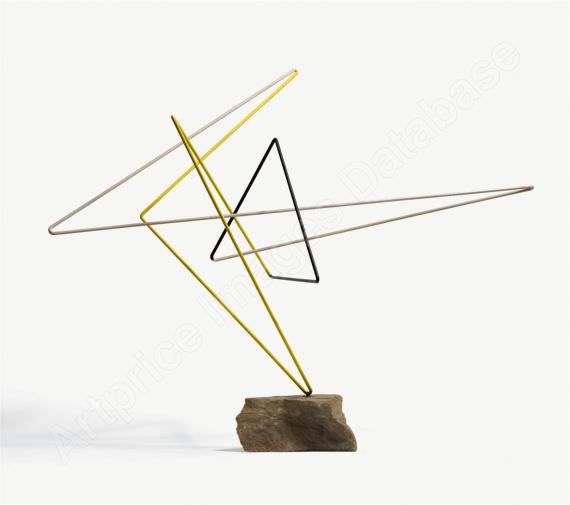Altre immagini
Altre immagini
Altre immagini
124000207
Norbert Kricke
Raumplastik Rot, 1952.
Steel, coated, mounted on a stone base
Stima: € 120,000 / $ 128,400
Le informationi sulla commissione, le tasse e il diritto di seguito saranno disponibili quattro settimane prima dell´asta.
Raumplastik Rot. 1952.
Steel, coated, mounted on a stone base.
Total dimensions: 136.5 x 35 x 42 cm (53.7 x 13.7 x 16.5 in). Base: 6,5 x 20 x 17 cm (2,5 x 7,8 x 6,6 in).
[KT].
• Kricke's spatial sculptures resemble gravity-free gestures
• Forces, dynamics and energies become accessible as fundamentally new motifs of sculpture in Kricke's work.
• Kricke's early spatial sculptures anticipated the minimalist linear aesthetic of the American Fred Sandback from the following generation.
• As early as 1961, the Museum of Modern Art in New York presented the artist's first solo exhibition in the USA.
• Linear spatial sculptures from the early 1950s are extremely rare on the auction market.
• The counterpart “Raumplastik Blau” from 1952 is in the Museum Ludwig, Cologne.
Accompanied by a written certificate of authenticity issued by Sabine Kricke-Güse, Berlin, from May 23, 2016.
PROVENANCE:
From the artist's estate.
Galerie Aurel Scheibler, Berlin (acquired from the above).
Private collection Northern Germany (acquired from the above).
"I'm neither concerned with mass nor figures, I'm concerned with space and movement - space and time. I don't want a real space or a real movement (mobile), I want to represent movement. I try to give form to the unity of space and time. “
Quoted from: Carola Giedion-Welcker: Plastik des XX. Jahrhunderts. Volumen und Raumgestaltung, Stuttgart 1955, p. 197
“Movement and space, not figure and mass, are my concern”
Norbert Kricke
Steel, coated, mounted on a stone base.
Total dimensions: 136.5 x 35 x 42 cm (53.7 x 13.7 x 16.5 in). Base: 6,5 x 20 x 17 cm (2,5 x 7,8 x 6,6 in).
[KT].
• Kricke's spatial sculptures resemble gravity-free gestures
• Forces, dynamics and energies become accessible as fundamentally new motifs of sculpture in Kricke's work.
• Kricke's early spatial sculptures anticipated the minimalist linear aesthetic of the American Fred Sandback from the following generation.
• As early as 1961, the Museum of Modern Art in New York presented the artist's first solo exhibition in the USA.
• Linear spatial sculptures from the early 1950s are extremely rare on the auction market.
• The counterpart “Raumplastik Blau” from 1952 is in the Museum Ludwig, Cologne.
Accompanied by a written certificate of authenticity issued by Sabine Kricke-Güse, Berlin, from May 23, 2016.
PROVENANCE:
From the artist's estate.
Galerie Aurel Scheibler, Berlin (acquired from the above).
Private collection Northern Germany (acquired from the above).
"I'm neither concerned with mass nor figures, I'm concerned with space and movement - space and time. I don't want a real space or a real movement (mobile), I want to represent movement. I try to give form to the unity of space and time. “
Quoted from: Carola Giedion-Welcker: Plastik des XX. Jahrhunderts. Volumen und Raumgestaltung, Stuttgart 1955, p. 197
“Movement and space, not figure and mass, are my concern”
Norbert Kricke
“My problem is not mass, is not figure, but it is space, and it is movement - space and time”, is how Norbert Kricke described his artistic setting in the early 1950s (quoted from Carola Giedion-Welcker, Plastik des XX. Jahrhunderts. Volumen und Raumgestaltung, Stuttgart 1955, p. 197). And indeed, the lines of 'steel' in their moving 'hiddenness' in the early spatial sculptures show a calligraphic moment that 'solidifies' into a form over several changes of direction. This is the basic concept of Kricke's works in those days: The artist created motion in space from a single steel line, which, over several changes of direction in the form of a 'figure', makes its claim to space tangible and takes on a variety of forms in sequences of movement and with well-placed colors. Kricke's figures conceived from moving lines, which he calls 'spatial sculptures', convey a sense of lightness in many different ways.
Norbert Kricke's decades-long, expansive work began after the end of the war. Initially, he studied under the sculptor Richard Scheibe at the Hochschule der Bildende Künste in Berlin, where he met Hans Uhlmann in 1950. There he met Hans Uhlmann in 1950, who was probably the first to explore the potential of wire sculptures. "And this first source of inspiration has perhaps remained the most formative one - especially Uhlmann's wire sculptures from 1946/47," Florian Illies reports, "in which he forms elegiac shapes from a piece of wire, in which the material seems to curiously look around in a vacuum. This was the first time Kricke saw impatient spatial curves that wanted to detach themselves from their pedestal. Indeed, Kricke learned from Uhlmann that metal can be as flexible as a willow rod, and, surprisingly, this decisive impulse is repeatedly overlooked. Kricke learned the material's potential and the redemptive powers of abstraction here - even if his teacher's wire structures still allow associations with birds or organic figurations, which was ruled out from the outset in Kricke's work." (Florian Illies, Norbert Kricke zu 100. Geburtstag, Galerie Utermann, Dortmund, 2022, p. 12) Just how close teacher and student were at the time is demonstrated by the moving juxtaposition of two spatial explorations that can be found in this catalog and the auction: a playful and at the same time condensed spatial volte by Uhlmann here (called up in our Evening Sale: Draht-Plastik, 1949, iron, mounted on a wooden base, lot 29), a sober, almost reduced position by Kricke there. The joint exploration came to an end, so to speak, when Kricke moved to Düsseldorf. In Düsseldorf in his late twenties, Kricke then found his vocabulary, from which he was able to draw new formulations for over three decades and which made him an exceptional artist as a sculptor, with a distinctive position in German art after 1945. In the 1950s, Kricke initially began to explore the dynamics of the line by using a single bent wire. For these early, mostly colorful works, the title "spatial sculpture" finds its literal use and becomes the pivotal point of his work.
In the major retrospective exhibition "Kunst in der Bundesrepublik Deutschland 1945-1985" at the Nationalgalerie in Berlin in 1985, the director and exhibition curator Dieter Honisch praised Kricke's contemporary contribution to post-war art as "informal", because of the dissolution of the sculptural body, "Uhlmann thought more about figuration and Kricke more about movement in space" and his "peculiar disembodied and immaterial space-time structures, which attracted attention far beyond Germany in the 1950s" (pp. 132 f. ) Werner Haftmann invited Kricke to the second documenta in 1959, the Museum of Modern Art in New York dedicated a solo exhibition to Kricke in 1961, and he exhibited at the German Pavilion in Venice in 1964. Carola Giedion-Welcker contextualized the sculptor historically when she wrote: "Since Pevsner, Gabo, and Gonzalez, encircling compositions and air-flooded, linearly articulations have been developed in ever new idioms. The intensive dialog with space has drowned out all 'background noise' and has become essential. Norbert Kricke is one of the most unconventional and imaginative young sculptors who have realized linear dynamics with a pronounced accentuation of the temporal moment, the pace, in their constructions." (Carola Giedion-Welcker in: Norbert Kricke. XXXII Biennale di Venecia 1964, no p.) The author, as well as her husband, the Swiss architecture historian Sigfried Giedion, who had close intellectual ties to Kricke and was in a lively exchange of ideas with him, also describes the artist's obvious urge towards a beautifully shaped Minimalism, which, as is the case here, the repeatedly bent steel wire grows out of the base into space with a slight curve and, after a few more or less playful, mostly horizontal whirls, returns to the plinth. Kricke was inspired by the constructivist sculpture of Naum Gabo and Antoine Pevsner, the sculptor brothers of Russian Suprematism and Constructivism. Wire structures such as those by Oskar Schlemmer and his figure studies at the Bauhaus may also have inspired Uhlmann's early constructions. In photography, the abstractly understood lines, forms, and graphic structures were also reflected in Otto Steinert's works from the same period (called up in our Contemporary Art Day Sale, lot 123: Otto Steinert, Rotierende Drahtfigur. Design for the catalog cover of the exhibition “Subjektive Fotografie” in Saarbrücken, 1951, gelatin silver print). With his singular objects, he created a formal language that is still unparalleled to this day, transferring the linear aesthetics of Informalism, such as the black contours of Ernst Wilhelm Nay's color fields, into sculpture, thus making them tangible. "His spatial sculptures do not point the way in space, no, they leave traces that our eye follows - and it is precisely this movement of the eye that simultaneously establishes a temporal experience," Florian Illies explains once again (ibid.) Kricke transforms these filigree metal lines into a more dynamic diagonal course of a single line that rises, falls, and flows back into itself, forming a kind of unity in its arc. From the mid-fifties, Kricke expanded this concept and produced the 'knot', a form of an expressive, disorderly network of lines that flow and swirl in all directions to create a "spatial sculpture" of Abstract Expressionism. [MvL]
Norbert Kricke's decades-long, expansive work began after the end of the war. Initially, he studied under the sculptor Richard Scheibe at the Hochschule der Bildende Künste in Berlin, where he met Hans Uhlmann in 1950. There he met Hans Uhlmann in 1950, who was probably the first to explore the potential of wire sculptures. "And this first source of inspiration has perhaps remained the most formative one - especially Uhlmann's wire sculptures from 1946/47," Florian Illies reports, "in which he forms elegiac shapes from a piece of wire, in which the material seems to curiously look around in a vacuum. This was the first time Kricke saw impatient spatial curves that wanted to detach themselves from their pedestal. Indeed, Kricke learned from Uhlmann that metal can be as flexible as a willow rod, and, surprisingly, this decisive impulse is repeatedly overlooked. Kricke learned the material's potential and the redemptive powers of abstraction here - even if his teacher's wire structures still allow associations with birds or organic figurations, which was ruled out from the outset in Kricke's work." (Florian Illies, Norbert Kricke zu 100. Geburtstag, Galerie Utermann, Dortmund, 2022, p. 12) Just how close teacher and student were at the time is demonstrated by the moving juxtaposition of two spatial explorations that can be found in this catalog and the auction: a playful and at the same time condensed spatial volte by Uhlmann here (called up in our Evening Sale: Draht-Plastik, 1949, iron, mounted on a wooden base, lot 29), a sober, almost reduced position by Kricke there. The joint exploration came to an end, so to speak, when Kricke moved to Düsseldorf. In Düsseldorf in his late twenties, Kricke then found his vocabulary, from which he was able to draw new formulations for over three decades and which made him an exceptional artist as a sculptor, with a distinctive position in German art after 1945. In the 1950s, Kricke initially began to explore the dynamics of the line by using a single bent wire. For these early, mostly colorful works, the title "spatial sculpture" finds its literal use and becomes the pivotal point of his work.
In the major retrospective exhibition "Kunst in der Bundesrepublik Deutschland 1945-1985" at the Nationalgalerie in Berlin in 1985, the director and exhibition curator Dieter Honisch praised Kricke's contemporary contribution to post-war art as "informal", because of the dissolution of the sculptural body, "Uhlmann thought more about figuration and Kricke more about movement in space" and his "peculiar disembodied and immaterial space-time structures, which attracted attention far beyond Germany in the 1950s" (pp. 132 f. ) Werner Haftmann invited Kricke to the second documenta in 1959, the Museum of Modern Art in New York dedicated a solo exhibition to Kricke in 1961, and he exhibited at the German Pavilion in Venice in 1964. Carola Giedion-Welcker contextualized the sculptor historically when she wrote: "Since Pevsner, Gabo, and Gonzalez, encircling compositions and air-flooded, linearly articulations have been developed in ever new idioms. The intensive dialog with space has drowned out all 'background noise' and has become essential. Norbert Kricke is one of the most unconventional and imaginative young sculptors who have realized linear dynamics with a pronounced accentuation of the temporal moment, the pace, in their constructions." (Carola Giedion-Welcker in: Norbert Kricke. XXXII Biennale di Venecia 1964, no p.) The author, as well as her husband, the Swiss architecture historian Sigfried Giedion, who had close intellectual ties to Kricke and was in a lively exchange of ideas with him, also describes the artist's obvious urge towards a beautifully shaped Minimalism, which, as is the case here, the repeatedly bent steel wire grows out of the base into space with a slight curve and, after a few more or less playful, mostly horizontal whirls, returns to the plinth. Kricke was inspired by the constructivist sculpture of Naum Gabo and Antoine Pevsner, the sculptor brothers of Russian Suprematism and Constructivism. Wire structures such as those by Oskar Schlemmer and his figure studies at the Bauhaus may also have inspired Uhlmann's early constructions. In photography, the abstractly understood lines, forms, and graphic structures were also reflected in Otto Steinert's works from the same period (called up in our Contemporary Art Day Sale, lot 123: Otto Steinert, Rotierende Drahtfigur. Design for the catalog cover of the exhibition “Subjektive Fotografie” in Saarbrücken, 1951, gelatin silver print). With his singular objects, he created a formal language that is still unparalleled to this day, transferring the linear aesthetics of Informalism, such as the black contours of Ernst Wilhelm Nay's color fields, into sculpture, thus making them tangible. "His spatial sculptures do not point the way in space, no, they leave traces that our eye follows - and it is precisely this movement of the eye that simultaneously establishes a temporal experience," Florian Illies explains once again (ibid.) Kricke transforms these filigree metal lines into a more dynamic diagonal course of a single line that rises, falls, and flows back into itself, forming a kind of unity in its arc. From the mid-fifties, Kricke expanded this concept and produced the 'knot', a form of an expressive, disorderly network of lines that flow and swirl in all directions to create a "spatial sculpture" of Abstract Expressionism. [MvL]
124000207
Norbert Kricke
Raumplastik Rot, 1952.
Steel, coated, mounted on a stone base
Stima: € 120,000 / $ 128,400
Le informationi sulla commissione, le tasse e il diritto di seguito saranno disponibili quattro settimane prima dell´asta.




 Lot 124000207
Lot 124000207 

